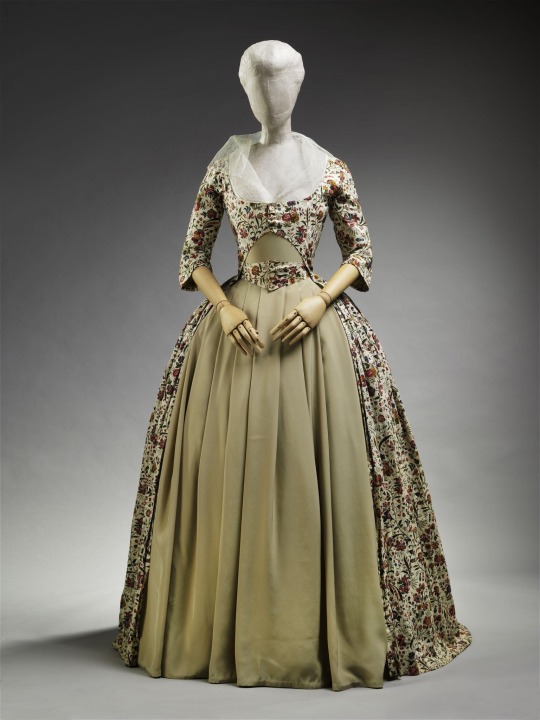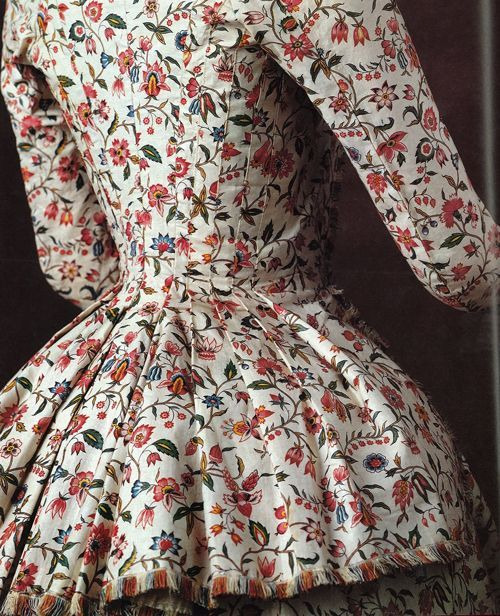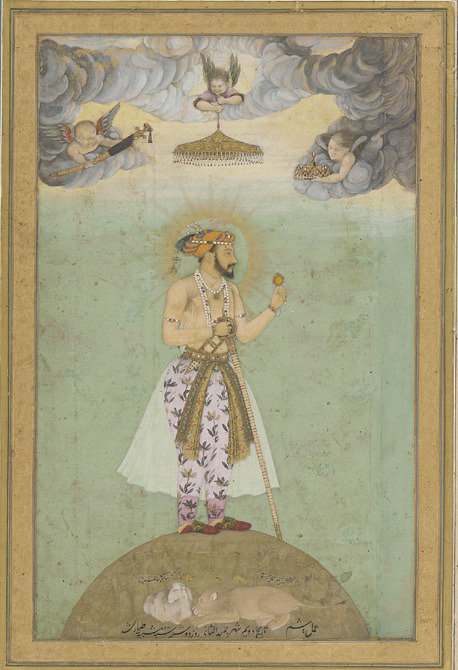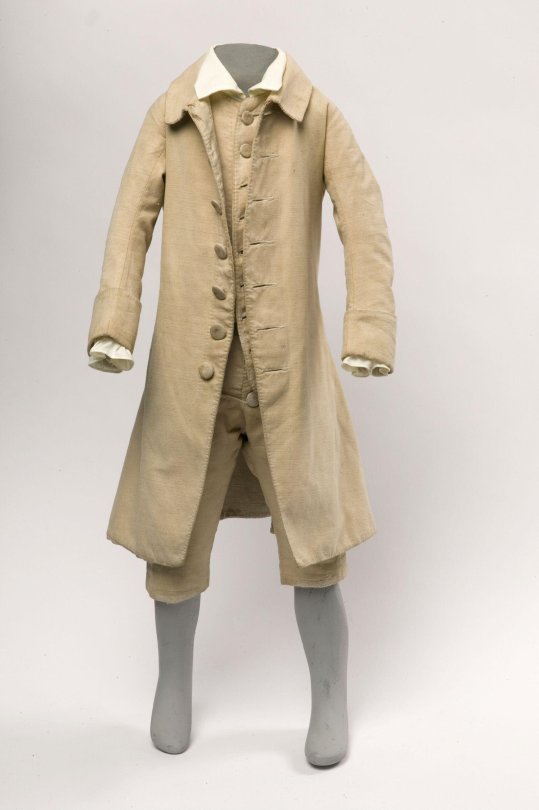#1780s England
Text



Beige Floral Cotton Dress, 1780-1785, English.
Victoria and Albert Museum.
#V&A#floral#cotton#beige#extant garments#womenswear#dress#1780#1780s#1780s dress#1780s extant garment#1780s England#1780s Britain#British#English
268 notes
·
View notes
Text


Robe à la française
1750s; Altered 1780s & Late 19th Century
France & England
The ensemble was probably made as a sack and petticoat in the 1750s. In the 1780s, the sack was updated in style. A waist seam was probably added, the skirts reconfigured, and sleeve ruffles removed. The half-stomachers were added at this time and the bodice fronts relined. The back lacing was reconfigured and more eyelets worked.
The ensemble was altered for fancy dress in the late 19th century. Hooks and eyes were added to the bodice stomacher fronts and machine-lace ruffles to the sleeves. The petticoat may have been unpicked at this point.
The petticoat was gathered onto a cotton band after acquisition for Museum display. (V&A)
Victoria & Albert Museum (Accession Number: CIRC.157-1920)
#robe a la francaise#fancy dress#fashion history#historical fashion#1750s#1780s#19th century#georgian#victorian#france#england#v and a#v and a museum#popular
1K notes
·
View notes
Text
The famous anti-slavery token made by the Wedgewood pottery in 1787 entitled 'Am I not a Man and a Brother?' was popular among abolitionists in England. But it would be 1838 before a coin was struck for enslaved women's rights – 'Am I not a Woman and a Sister?' – and then it was made for the American Anti-Slavery Society and popular in America.

English elite women did not feel a sisterhood with women of a lower class or another race. Elite women called for political rights for their own class, not for anyone else. They even used the example of slavery to support their campaign – comparing their inequality to slavery.
"Normal Women: 900 Years of Making History" - Philippa Gregory
#book quotes#normal women#philippa gregory#nonfiction#anti slavery#token#wedgewood pottery#80s#1780s#18th century#am i not a man and a brother#abolitionist#england#30s#1830s#19th century#coin#am i not a woman and a sister#american anti slavery society#classism#white feminism#slavery#sisterhood#solidarity
19 notes
·
View notes
Photo

Mother Ludlam's Hole, near Farnham, by Samuel Hieronymus Grimm, Great Britain, 1781.
#Mother Ludlam's Hole#Mother Ludlam's Cave#according to legend a white witch used to live in the cave#also the monks of Waverley Abbey used the spring in the cave as a water source#by the 1820s it was in a state of neglect and the roof caved in back in the 1960s or 70s which is unfortunate#from photos it seems it's not completely buried but there's a big pile of dirt and sand and rock#sandstone#wey valley#moor park#farnham#surrey#england#britain#europe#caves#places#natural springs#Samuel Hieronymus Grimm#1780s#18th century#Georgian era#watercolour#paintings
33 notes
·
View notes
Text




John Hancock became the first Governor of Massachusetts on October 25, 1780.
#John Hancock memorial#John Hancock#first Governor of Massachusetts#USA#Granary Burying Ground#Park Street Church#25 October 1780#travel#architecture#cityscape#anniversary#us history#Peter Banner#Freedom Trail#Boston#Massachusetts#New England#summer 2018#original photography#tourist attraction#landmark
6 notes
·
View notes
Text
My problem with shows and movies set in modern time is that if i wanted to see modern time i’d look out the window. i have the blinds shut. I do not want to see. Show me a medieval castle.
#partially about the sandman#period dramas#tv shows#netflix#pjo is an exception i hope i won’t have to explain#all these netflix trash shows#like stop#but i’d watch first kill if it was set in 1824 scandinavia#or 1780’s france#or 1600’s england
5 notes
·
View notes
Text

No Way Back, by Valerie Wilding. One of a handful in this series based on a true story. At first I thought it was odd that they would include this book after using the one from My Australian Story (coming up next), but after reading both, I’ll concede that they are about different aspects of the convict experience.
Mary was supposedly 9-10 years old during this story, but she talked and acted like someone in their late teens. The formatting is confusing because it reads and is narrated like a diary, but there’s no way that Mary could be writing things down.
Goodreads star rating: 3/5
#no way back#my story uk#mary wade#london#england#new south wales#australia#1780s#1790s#valerie wilding#books
3 notes
·
View notes
Text
Known fact this is what happens if a composer of the 1700s here their songs in a remix?

0 notes
Text
An innovation that propelled Britain to become the world’s leading iron exporter during the Industrial Revolution was appropriated from an 18th-century Jamaican foundry, historical records suggest.
The Cort process, which allowed wrought iron to be mass-produced from scrap iron for the first time, has long been attributed to the British financier turned ironmaster Henry Cort. It helped launch Britain as an economic superpower and transformed the face of the country with “iron palaces”, including Crystal Palace, Kew Gardens’ Temperate House and the arches at St Pancras train station.
Now, an analysis of correspondence, shipping records and contemporary newspaper reports reveals the innovation was first developed by 76 black Jamaican metallurgists at an ironworks near Morant Bay, Jamaica. Many of these metalworkers were enslaved people trafficked from west and central Africa, which had thriving iron-working industries at the time.
Dr Jenny Bulstrode, a lecturer in history of science and technology at University College London (UCL) and author of the paper, said: “This innovation kicks off Britain as a major iron producer and … was one of the most important innovations in the making of the modern world.”
The technique was patented by Cort in the 1780s and he is widely credited as the inventor, with the Times lauding him as “father of the iron trade” after his death. The latest research presents a different narrative, suggesting Cort shipped his machinery – and the fully fledged innovation – to Portsmouth from a Jamaican foundry that was forcibly shut down.
[...]
The paper, published in the journal History and Technology, traces how Cort learned of the Jamaican ironworks from a visiting cousin, a West Indies ship’s master who regularly transported “prizes” – vessels, cargo and equipment seized through military action – from Jamaica to England. Just months later, the British government placed Jamaica under military law and ordered the ironworks to be destroyed, claiming it could be used by rebels to convert scrap metal into weapons to overthrow colonial rule.
“The story here is Britain closing down, through military force, competition,” said Bulstrode.
The machinery was acquired by Cort and shipped to Portsmouth, where he patented the innovation. Five years later, Cort was discovered to have embezzled vast sums from navy wages and the patents were confiscated and made public, allowing widespread adoption in British ironworks.
Bulstrode hopes to challenge existing narratives of innovation. “If you ask people about the model of an innovator, they think of Elon Musk or some old white guy in a lab coat,” she said. “They don’t think of black people, enslaved, in Jamaica in the 18th century.”
848 notes
·
View notes
Text

White Printed Cotton Dress, 1780s, English.
Victoria and Albert Museum.
#white#cotton#dress#womenswear#extant garments#1780s#1780s England#English#British#1780s Britain#1780s dress#18th century#V&A
124 notes
·
View notes
Note
How did cotton win over linen anyway?
In short, colonialism, slavery and the industrial revolution. In length:
Cotton doesn't grow in Europe so before the Modern Era, cotton was rare and used in small quantities for specific purposes (lining doublets for example). The thing with cotton is, that's it can be printed with dye very easily. The colors are bright and they don't fade easily. With wool and silk fabrics, which were the more traditional fabrics for outer wear in Europe (silk for upper classes of course), patterns usually needed to be embroidered or woven to the cloth to last, which was very expensive. Wool is extremely hard to print to anything detailed that would stay even with modern technology. Silk can be printed easily today with screen printing, but before late 18th century the technique wasn't known in western world (it was invented in China a millenium ago) and the available methods didn't yeld good results.
So when in the late 17th century European trading companies were establishing trading posts in India, a huge producer of cotton fabrics, suddenly cotton was much more available in Europe. Indian calico cotton, which was sturdy and cheap and was painted or printed with colorful and intricate floral patters, chintz, especially caught on and became very fashionable. The popular Orientalism of the time also contributed to it becoming fasionable, chintz was seen as "exotic" and therefore appealing.

Here's a typical calico jacket from late 18th century. The ones in European markets often had white background, but red background was also fairly common.
The problem with this was that this was not great for the business of the European fabric producers, especially silk producers in France and wool producers in England, who before were dominating the European textile market and didn't like that they now had competition. So European countries imposed trade restrictions for Indian cotton, England banning cotton almost fully in 1721. Since the introduction of Indian cottons, there had been attempts to recreate it in Europe with little success. They didn't have nearly advanced enough fabric printing and cotton weaving techniques to match the level of Indian calico. Cotton trade with India didn't end though. The European trading companies would export Indian cottons to West African market to fund the trans-Atlantic slave trade that was growing quickly. European cottons were also imported to Africa. At first they didn't have great demand as they were so lacking compared to Indian cotton, but by the mid 1700s quality of English cotton had improved enough to be competitive.
Inventions in industrial textile machinery, specifically spinning jenny in 1780s and water frame in 1770s, would finally give England the advantages they needed to conquer the cotton market. These inventions allowed producing very cheap but good quality cotton and fabric printing, which would finally produce decent imitations of Indian calico in large quantities. Around the same time in mid 1700s, The East Indian Company had taken over Bengal and soon following most of the Indian sub-continent, effectively putting it under British colonial rule (but with a corporate rule dystopian twist). So when industrialized English cotton took over the market, The East India Company would suppress Indian textile industry to utilize Indian raw cotton production for English textile industry and then import cotton textiles back to India. In 1750s India's exports were mainly fine cotton and silk, but during the next century Indian export would become mostly raw materials. They effectively de-industrialized India to industrialize England further.
India, most notably Bengal area, had been an international textile hub for millennia, producing the finest cottons and silks with extremely advance techniques. Loosing cotton textile industry devastated Indian local economies and eradicated many traditional textile craft skills. Perhaps the most glaring example is that of Dhaka muslin. Named after the city in Bengal it was produced in, it was extremely fine and thin cotton requiring very complicated and time consuming spinning process, painstakingly meticulous hand-weaving process and a very specific breed of cotton. It was basically transparent as seen depicted in this Mughal painting from early 17th century.

It was used by e.g. the ancient Greeks, Mughal emperors and, while the methods and it's production was systematically being destroyed by the British to squash competition, it became super fashionable in Europe. It was extremely expensive, even more so than silk, which is probably why it became so popular among the rich. In 1780s Marie Antoinette famously and scandalously wore chemise a la reine made from multiple layers of Dhaka muslin. In 1790s, when the empire silhouette took over, it became even more popular, continuing to the very early 1800s, till Dhaka muslin production fully collapsed and the knowledge and skill to produce it were lost. But earlier this year, after years lasting research to revive the Dhaka muslin funded by Bangladeshi government, they actually recreated it after finding the right right cotton plant and gathering spinners and weavers skilled in traditional craft to train with it. (It's super cool and I'm making a whole post about it (it has been in the making for months now) so I won't extend this post more.)


Marie Antoinette in the famous painting with wearing Dhaka muslin in 1783, and empress Joséphine Bonaparte in 1801 also wearing Dhaka muslin.
While the trans-Atlantic slave trade was partly funded by the cotton trade and industrial English cotton, the slave trade would also be used to bolster the emerging English cotton industry by forcing African slaves to work in the cotton plantations of Southern US. This produced even more (and cheaper (again slave labor)) raw material, which allowed the quick upward scaling of the cotton factories in Britain. Cotton was what really kicked off the industrial revolution, and it started in England, because they colonized their biggest competitor India and therefore were able to take hold of the whole cotton market and fund rapid industrialization.
Eventually the availability of cotton, increase in ready-made clothing and the luxurious reputation of cotton lead to cotton underwear replacing linen underwear (and eventually sheets) (the far superior option for the reasons I talked about here) in early Victorian Era. Before Victorian era underwear was very practical, just simple rectangles and triangles sewn together. It was just meant to protect the outer clothing and the skin, and it wasn't seen anyway, so why put the relatively scarce resources into making it pretty? Well, by the mid 1800s England was basically fully industrialized and resource were not scarce anymore. Middle class was increasing during the Victorian Era and, after the hard won battles of the workers movement, the conditions of workers was improving a bit. That combined with decrease in prices of clothing, most people were able to partake in fashion. This of course led to the upper classes finding new ways to separate themselves from lower classes. One of these things was getting fancy underwear. Fine cotton kept the fancy reputation it had gained first as an exotic new commodity in late 17th century and then in Regency Era as the extremely expensive fabric of queens and empresses. Cotton also is softer than linen, and therefore was seen as more luxurious against skin. So cotton shifts became the fancier shifts. At the same time cotton drawers were becoming common additional underwear for women.
It wouldn't stay as an upper class thing, because as said cotton was cheap and available. Ready-made clothing also helped spread the fancier cotton underwear, as then you could buy fairly cheaply pretty underwear and you didn't even have to put extra effort into it's decoration. At the same time cotton industry was massive and powerful and very much eager to promote cotton underwear as it would make a very steady and long lasting demand for cotton.
In conclusion, cotton has a dark and bloody history and it didn't become the standard underwear fabric for very good reasons.
Here's couple of excellent sources regarding the history of cotton industry:
The European Response to Indian Cottons, Prasannan Parthasarathi
INDIAN COTTON MILLS AND THE BRITISH ECONOMIC POLICY, 1854-1894, Rajib Lochan Sahoo
#i have fixed the wording in the beginning so it doesn't sound like i'm saying cotton in general dyed better than wool or silk#answers#fashion history#historical fashion#history#textile history#dress history#historical clothing#indian history#colonial history#indian textiles#cotton#slavery
2K notes
·
View notes
Text
The Chevalier d'Éon (1728-1810) was raised in France as the male heir to the Beaumont family. The decorated soldier dressed as a man to serve as a captain of Dragoons, and as a woman named Lia de Beaumont to spy for France on Russia and England. A master fencer, the Chevalier is shown here on the right in a celebrated match against Chevalier de St Georges. This was painted by Alexandre-Auguste Robineau c.1787.

"Normal Women: 900 Years of Making History" - Philippa Gregory
#book quotes#normal women#philippa gregory#nonfiction#chevalier d'eon#france#beaumont#soldier#dragoons#captain#lia de beaumont#spy#russia#england#fencing#chevalier de saint georges#alexandre auguste robineau#80s#1780s#18th century
5 notes
·
View notes
Photo

December, Robert Dighton, England, c. 1785
#look at that cattt#he's sleebing he's asleeb#1780s#georgian era#women#kinda cozy#there's like a square where you can see that the head and stuff are on another piece of paper so wonder what that's about#december#18th century#Robert Dighton#london#england#britain#europe#paintings#watercolor#night
3 notes
·
View notes
Photo




John Hancock became the first Governor of Massachusetts on October 25, 1780.
#John Hancock memorial#John Hancock#first Governor of Massachusetts#USA#Granary Burying Ground#Park Street Church#25 October 1780#travel#architecture#cityscape#anniversary#us history#Peter Banner#Freedom Trail#Boston#Massachusetts#New England#summer 2018#original photography#tourist attraction#landmark
1 note
·
View note
Text



ab. 1780 Boy's suit (coat, waistcoat and breeches) (England)
linen
(Victoria and Albert Museum)
164 notes
·
View notes
Text

The Public Universal Friend is said to have claimed that the Dark Day in New England in 1780 was a fulfillment of parts of Revelation.
The darkness and yellow skies that spring are now believed to have been caused by extensive wildfire smoke.
#my art#digital art#history#public universal friend#1780s#stayed up most of the night to get this image out of my head
237 notes
·
View notes